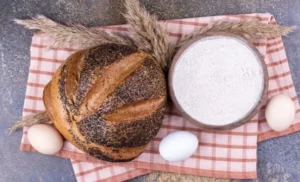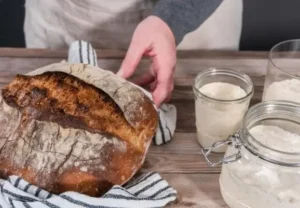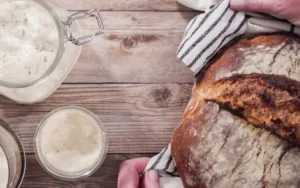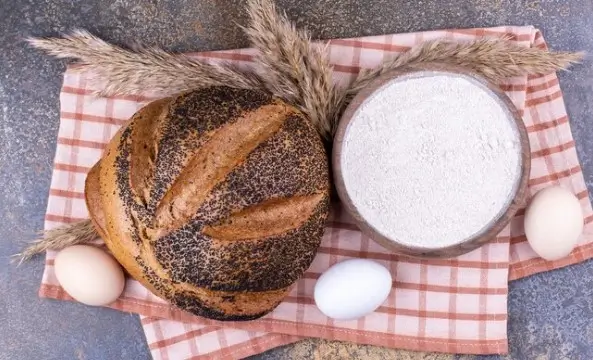Ben Starr Sourdough Starter Recipe
How many times do you have thought about how to create delicious homemade sourdough bread like the one made by experienced bakers? To get that crusty outside and the soft, tangily slightly sour inside it is all about building up a great sourdough starter.

The prolific culinary master, Ben Starr, has shared his top-secret solutions on how to cultivate and sustain a healthy and vibrant sourdough community. In this article, you shall learn the recipe and practices that Starr has developed, over the years, for the proper feeding and care of your sourdough starter.
No matter the level of your baking experience, having a good understanding of this basic element will make you a better baker and allow you to create many amazing delicious breads in your home. I have 20 years of experience in cooking. So you can trust me.
Overview of Ben Starr’s Sourdough Starter Recipe
Ben Starr’s sourdough starter is one of the trending recipes in the bread world because of the blunt truth it holds. This method provides a simple solution that includes an exciting, active, and lively starter that serves as the base for making tasty and wholesome homemade sourdough bread.
Key Ingredients
The recipe calls for just two basic ingredients: whole wheat flour and water. Wild yeast and essential nutrients are present in whole wheat flour, which makes it proper to kick off the activity of fermentation. To avoid influences possibly arising from water chlorination or other chemicals, it is advised to use only filtered water or spring water.
The Process
In her method, Starr insists that seekers should mix equal proportions of flour and water by weight, usually beginning with 50 grams of each measure. Their mixture is placed at an environment-friendly room temperature also recommended is to cover the dough with an improvised breathing cloth whereby the dough is again supplemented with fresh flour and warm water daily.
In about one week the starter smells and feels tangy and frothy as this is marked by an active colony of wild yeasts and bacteria.
Maintenance and Use
Starter once prepared, needs constant feeding to keep it active and strong all the time. Starr suggests the following feeding schedule that can be fine-tuned depending on how frequently you bake and the prevailing temperature.
This highly tenacious culture can be employed to leaven bread, prepare appetizing pancakes, or any food in which including a shot of probiotics may be desired.
Ingredients Needed for the Sourdough Starter
If you don’t want to buy a sourdough starter then it’s easy to make one and all you need are a few things. Here’s what you’ll need to embark on your sourdough journey:
Flour
Flour is what is the basic ingredient in your starter. While you can use various types, many bakers prefer a combination of:
- All-purpose flour: It provides a good balance between protein and starch and It offers efficient protection between protein and starch.
- Whole wheat flour: It’s full of nutrients and will have wild yeast, a great starter culture for fermentation.
The best result will be achieved with organic (unbleached) flour so as to avoid any additives that may impede the fermentation.
Water
So if you don’t want to destroy your starter, use water with no chlorine in it. For the chlorine to evaporate, stand your tap water for 24 hours before using it. You can also bottle the water you use to let yeast and bacteria grow.
Container
Select a container that will not react with your starter to store it in. Any glass jar with an open lid or a food-grade plastic bin with a hole in the lid will do. Make sure that it’s big enough to allow the starter to grow during the fermentation process.
Optional Additions
However, some bakers add small amounts of high-risk products such as rye flour or pineapple juice, with the purpose of starting fermentation. These can supplement other nutrients and enhance sourdough bread’s taste once they have been incorporated into your starter.
Step-by-Step Instructions for Making the Starter
Gathering Your Ingredients
To begin your sourdough starter journey, you’ll need just two simple ingredients: whole wheat flour and water. Yeast flour should preferably be whole wheat since it has more wild yeast and bacteria than refined flour which will help your starter to ferment.

The Initial Mix
Begin with an equal quantity of flour by weight, and an equal quantity of water, preferably, and mix them in a clear glass or ceramic bowl. It does not hurt to start with 50 grams of each. Stir vigorously until you have no dry powder left and should have a dense batter.
After soiling the container, only partially cover it with a cloth or a lid to allow air to get in but with other pollutants locked out.
Feeding Schedule
For the next 5-7 days, you will just have to maintain your starter by ‘feeding’ it daily. Throw away everything but 50 grams of the mixture each day and add both 50 grams of flour and water. Stir well and cover again. It assists in the support of the growth of the desired microorganisms and at the same time avoids the build-up of alcohol and acid.
Monitoring Progress
Over time you should expect a change in the physical appearance of your starter as days go by. It will start to ferment, produce a nice poo r smell and rise twice its size within feedings. These are signs that your starter is becoming active and healthy.
It is crucial to be patient at this stage because it will probably take up to two weeks for a starter to become fully mature.
Tips for Maintaining and Feeding Your Starter
Consistency is Key
Sourdough culture on the other hand needs time and commitment to ensure that it is healthy all the time. Stick to a feeding schedule, be it once a day, or more often if possible it is helpful to utilize the same time. This routine also helps you build a strong culture of wild yeast and other good bacteria for your starter to grow lively.
The Right Environment Matters
Your starter likes warm, draft-free conditions such as inside an oven, incubator, or any warm and dry space. Use a temperature setting of 70-80°F (21-27°C) for the most desirable fermentation triggers. In colder regions, your starter should be taken to a warmer area of the house or near (but not touching) a warm source such as an oven with only the light on.
Feeding Ratios and Flour Choice
A common feeding ratio is 1:The optimal ratio according to the dry weight ratio was 1:1:1 (starter: water: flour respectively). Still, you can do this depending on your starter’s activity as well as your baking timetable.
Depending on the water content, try to find out which type of flour is most effective for a particular starter. Intact grain flours are richer in nutrients, but all-purpose flour forms the soft texture base in baked goods.
Signs of a Healthy Starter
A good starter should take 4-8 hours to double in size after feeding and should have an odor that is pleasant, and slightly tangy. In a fermenting dough, bubbles appear to be spread all over the dough and the surfaces formed should be slightly domed. If your starter does not display these symptoms it may require more feedings per day or a change in environment.
How to Use the Sourdough Starter in Breads and Baked Goods
Incorporating Starter into Bread Recipes
So the moment your sourdough starter becomes fragrant and begins to bubble, you’re good to go and you can use it in baking. In deciding what to feed your starter, for the original American-style sourdough bread formula, simply add part of the flour and or water with the same amount of sourdough starter.

Typically, you work with 1/4 to 1/3 of a cup of starter per loaf in the bread-making process. Try to remember that the ratios of consistently remaining flour and water should also be adjusted simultaneously.
Experimenting with Other Baked Goods
It does not end in bread only This is something that tends to be ignored at times. Your sourdough starter can add a delightful tangy flavor to several other recipes, including pancakes waffles, and even pizza dough. For these recipes substitute approximately ¼ cup of the starter for a small portion of the flour and liquid.
This will impart a mild sourdough taste to your baked products but at the same time do not interfere with the primary source recipe.
Tips for Success
- When you are preparing to digest, always ensure you are using the most active starter usually 4- 8 hours after feeding it.
- Use a small amount of starter in recipes and adjust the starter until you achieve the palate you desire.
- Note your experiments to adjust your recipes to the optimum level subsequent time.
Of course, baking with sourdough is more of a science and creativity. Feel free to click on the recipes again and try to make tweaks that are closer to your palate. Over time, you learn how your starter reacts in various recipes and, thus design your baked products as per your preference.
Conclusion
As you bake with Ben Starr’s sourdough starter recipe, remember that it takes time as well as practice. By following these steps, and making sure I feed my starter daily, you’ll have a lively, bubbly, and active starter to be used for baking.
If your first tries are not ideal do not get upset – sourdough is more about art than about science. And remember, it isn’t a race, and we don’t have to be perfect we can take solace in the fact that every bake here is a learning process, a journey of discovery, towards the delicious and complex flavors and textures that true naturally leavened bread provides.
When you bake more often you get to know your starter like you would with a pet and you get to create wonderful artisanal bread that you can easily compete with some of the bakeries out there. Happy baking!
Frequently Asked Questions (FAQs)
How long does it take to create a sourdough starter?
When making sourdough starter it usually will take between about 5-7 days. But this often takes time, depending on the temperature at that particular place and atmosphere, or the kind of flour utilized. It is important to be also consistent with the feeding routine to see the best results.
What’s the best flour to use for a sourdough starter?
You may use any type of flour you wish, though most people who bake with whole wheat often employ a 50/50 mix of white and normal wheat flour. According to Clissa, whole wheat flour for example is richer in nutrients and wild yeast which can aid in kick-starting the fermentation process.
When the yeast begins to grow, you can choose to skip adding the bread flour and use all-purpose flour instead.
How often should I feed my sourdough starter?
For the new starter, this should be fed one or two times a day until it becomes more active and full of bubbles. Once prepared you can let it sit at room temperature and feed it daily or put it in the refrigerator and feed it weekly. This helps to avoid having too much left, yet enough must always be kept to serve the animals.
Why does my starter smell like alcohol?
An alcohol smell normally points to what your checker can tell you: If the starter is hungry it should be fed. This is observed when all the nutrients have been depleted, mostly the food part of the flour yeasts starts proving alcohol. To fix this, a simple way is to get rid of a small amount of it then use your starter to prepare the mixture you usually do.
Best Sourdough English Muffins Recipe Ever

Hello! My name is Wahab Khan. I, having over 20 years of culinary experience, bring both my knowledge and passion to each Recipe featured here. I create delicious, accessible dishes for beginners and seasoned cooks alike, and think that good food can help connect people. My recipes combine timeless techniques with stellar new spins, allowing readers to master the everyday flavors of the World.
